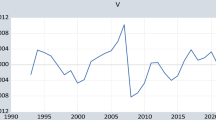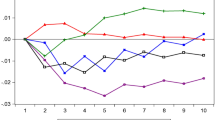Abstract
One of the most serious externalities of agricultural activity relates to greenhouse gas emissions. This work tests this relationship for the Portuguese case by examining data compiled since 1961. Employing cointegration techniques and vector error correction models (VECMs), we conclude that the evolution of the most representative vegetables and fruits in Portuguese production are associated with higher controls on the evolution of greenhouse gas emissions. Reversely, the evolution of the output levels of livestock and the most representative animal production have significantly increased the level of CO2 (carbon dioxide) reported in Portugal. We also analyze the cycle length of the long-term relationship between agricultural activity and greenhouse gas emissions. In particular, we highlight the case of synthetic fertilizers, whose values of CO2 have quickly risen due to changes in Portuguese vegetables, fruit, and animal production levels.





Similar content being viewed by others
Change history
26 July 2017
An erratum to this article has been published.
Notes
In Brazil, the growth process has not followed the typical pattern in which agriculture loses importance in favor of industry and services. The major explanation for this anomaly is associated with the capital intensity and productivity in the Brazilian agricultural sector (Spolador and Roe 2013). In Indian society, agriculture still accounts for approximately 58% of the active labor force. A balanced and sustainable economic growth pattern in India depends on the modernization of the agricultural sector and the consequent release of labor for other economic sectors through processes of technological intensification on the farms (Birthal et al. 2011).
Methane (CH4) and nitrous oxide (N2O) may be converted to CO2eq through conversion coefficients by considering the contribution of each gas for the global warming potential, where CO2 = 1, CH4 = 21, and N2O = 310 (GPP 2011b). Waste burning is related to vegetal residues such as the branches resulting from tree pruning.
Following Neuhaus (2006, p. 122), we must conclude that under a valid cointegration relationship, there is no serious issue with multicollinearity or endogeneity among the regressors. However, we ran tests on the multicollinearity of the independent variables of the six equations exhibited here and obtained variance inflation factors below 10 (favoring the hypothesis of non-multicollinearity). We also ran Durbin-Hausman-Hu tests on our six long-term equations and determined an absence of endogenous threats. Full details are available upon request.
For this statistics, we considered the values obtained for the Schwarz’s Bayesian information criterion (SBIC). Full results are available upon request.
For a comprehensive discussion on “Granger causality tests” and their meanings, follow Stern (2011).
References
Aguiar R, Santos FD (2007) Prospective model for greenhouse gas emissions in Portugal. Version 2.2. Final report, volume I: reference scenarios (in Portuguese). Project MISP – climate change: mitigation strategies in Portugal. Calouste Gulbenkian Foundation and Instituto D.Luiz, Lisbon
Al-mulali U, Fereidouni HG, Mohammed MAHB, Lee JYM (2016) Agriculture investment, output growth, and CO2 emissions relationship. Energy Sources Part B Econ Plan Policy 11(7):665–671
APA (2014) Inventário Nacional de Emissões Atmosféricas (NIR 2014 – emissões 2012): Memorando sobre emissões de CO2e elaborado com base na submissão oficial para a CE (Dec. 280/2004/CE). Departamento de Alterações Climáticas (DCLIMA). Agência Portuguesa do Ambiente, Amadora
Asumadu-Sarkodie S, Owusu PA (2016) The relationship between carbon dioxide and agriculture in Ghana: a comparison of VECM and ARDL model. Environ Sci Pollut Res 23:10968–10982
Barbier EB (2004) Agricultural expansion, resource booms and growth in Latin America: implications for long-run economic development. World Dev 32(1):137–157
Bellarby J, Tirado R, Leip A, Weiss F, Lesschen JP, Smith P (2013) Livestock greenhouse gas emissions and mitigation potential in Europe. Glob Chang Biol 19:3–18
Bentivoglio D, Finco A, Bacchi MR, Spedicato G (2014) European biodiesel market and rapeseed oil: what impact on agricultural food prices? Int J Global Energy Issues 37(5–6):220–235
Birthal PS, Singh H, Kumar S (2011) Agriculture, economic growth and regional disparities in India. J Int Dev 23:119–131
Blandford D, Gaasland I, Vårdal E (2014) The trade-off between food production and greenhouse gasmitigation in Norwegian agriculture. Agric Ecosyst Environ 184:59–66
Borrego C, Lopes M, Ribeiro I, Carvalho A (2009) As alterações climáticas: uma realidade transformada em desafio. Debater a Europa. Periódico do CIEDA e do CIEJD, em parceria com GPE, RCE e o CEIS20
Bourne M, Childs J, Philippidis G, Feijoo M (2012) Controlling greenhouse gas emissions in Spain: what are the costs for agricultural sectors? Span J Agric Res 10(3):567–582
Brückner M (2012) Economic growth, size of the agricultural sector, and urbanization in Africa. J Urban Econ 71:26–36
Campbell JY, Shiller RJ (1988) Interpreting cointegrated models. J Econ Dyn Control 12(2–3):505–522
Cao KH, Birchenall JA (2013) Agricultural productivity, structural change, and economic growth in post-reform China. J Dev Econ 104:165–180
Carillo F, Maietta OW (2014) The relationship between economic growth and environmental quality: the contributions of economic structure and agricultural policies. New Medit 13(1):15–21
Ceylan RF, Özkan B (2013) Agricultural value added and economic growth in the European Union accession process. New Medit 12(4):62–71
De Cara S, Jayet P-A (2011) Marginal abatement costs of greenhouse gas emissions from European agriculture, cost effectiveness, and the EU non-ETS burden sharing agreement. Ecol Econ 70:1680–1690
Engle R, Granger C (1987) Co-integration and error correction: representation, estimation, and testing. Econometrica 55(2):251–276
FAOSTAT (2015) Several statistics. Food and Agriculture Organization of the United Nations
GPP (2011a) A agricultura na economia Portuguesa envolvente, importância e evolução recente 2010. MAMAOT
GPP (2011b) Alterações climáticas: emissões de gases com efeito de estufa (GEE). Sector agro-pecuário 2009. Divisão de Alterações Climáticas e Biodiversidade, da Direcção de Serviços de Ambiente e Ordenamento do Espaço Rural. Gabinete de Planeamento e Políticas. MADRP
INE (2012) Indicadores Económico-ambientais – Conta das Emissões Atmosféricas 1995–2010. Conta das Emissões Atmosféricas: Emissões de gases de efeito estufa atingem mínimo histórico em 2010. Statistics Portugal
Jebli MB, Youssef SB (2017) Renewable energy consumption and agriculture: evidence for cointegration and Granger causality for Tunisian economy. Int J Sustain Dev World Ecol 24(2):149–158
Krolzig H, Hendry D (2000) Computer automation of general-to-specific model selection procedures. J Econ Dyn Control 25:831–866
Lehtinen T, Schlatter N, Baumgarten A, Bechini L, Kruger J, Grignani C, Zavattaro L, Costamagna C, Spiegel H (2014) Effect of crop residue incorporation on soil organic carbon and greenhouse gas emissions in European agricultural soils. Soil Use Manag 30:524–538
Lenzen M, Dey C, Foran B, Widmer-Cooper A, Ohlemüller R, Williams M, Wiedmann T (2013) Modelling interactions between economic activity, greenhouse gas emissions, biodiversity and agricultural production. Environ Model Assess 18:377–416
Lugato E, Zuliani M, Alberti G, Vedove GD, Gioli B, Miglietta F, Peressotti A (2010) Application of DNDC biogeochemistry model to estimate greenhouse gas emissions from Italian agricultural areas at high spatial resolution. Agric Ecosyst Environ 139:546–556
Mourao P (2015) The complex relation between the Belarusian trade openness and the agricultural sector. Land Use Policy 43(1):74–81
Neuhaus M (2006) The impact of FDI on economic growth: an analysis for the transition countries of central and Eastern Europe. Springer, New York
Pereira TC, Seabra T, Pina A, Canaveira P, Amaro A, Freitas L (2014) Portuguese national inventory report on greenhouse gases, 1990–2012. Submitted under the United Nations Framework Convention on Climate Change and the Kyoto Protocol. Portuguese Environmental Agency, Amadora
Rasetti M, Finco A, Bentivoglio D (2014) GHG balance of biodiesel production and consumption in EU. Int J Global Energy Issues 37(5–6):191–204
Seixas J, Simões S, Fortes P, Cleto J, Barroso JE, Alves B, Dinis R, Pisco F, Faria P, Finote S (2008) PortugalClima2020. Avaliação do impacto da proposta energia-clima da Comissão Europeia para Portugal. Trabalho realizado para: Comité Executivo – Comissão para as Alterações Climáticas, Agência Portuguesa para o Ambiente. E.Value, Lda. – Projectos e Estudos em Ambiente e Economia, Lisboa
Spolador HFS, Roe TL (2013) The role of agriculture on the recent Brazilian economic growth: how agriculture competes for resources. Dev Econ 51(4):333–359
Stern D (2011) “From correlation to Granger causality”. Crawford School Research Paper, n 13. Australian National University
Author information
Authors and Affiliations
Corresponding author
Additional information
Responsible editor: Philippe Garrigues
The authors acknowledge the suggestions provided by two anonymous reviewers of ‘Environmental Science and Pollution Research’ and by the participants at the “Management International Conference” (in Portoroz 2015) and at the Conference “Economics, Economic Policies and Sustainable Growth in the Wake of the Crisis” (in Ancona 2016), in which a previous version of this paper has been discussed. Remaining limitations are authors’ exclusive ones. The authors acknowledge, also, the Portuguese Foundation for Science and Technology (FCT) through the project PEst-OE/CED/UI4016/2014 and the Center for Studies in Education, Technologies and Health (CI&DETS).
An erratum to this article is available at https://doi.org/10.1007/s11356-017-9780-0.
Rights and permissions
About this article
Cite this article
Mourao, P.R., Domingues Martinho, V. Portuguese agriculture and the evolution of greenhouse gas emissions—can vegetables control livestock emissions?. Environ Sci Pollut Res 24, 16107–16119 (2017). https://doi.org/10.1007/s11356-017-9257-1
Received:
Accepted:
Published:
Issue Date:
DOI: https://doi.org/10.1007/s11356-017-9257-1




